Disclosure: We may earn commissions if you purchase products after clicking on a link from our site.
Do you want to learn how to catch California corbina? Do you want to catch one of the most popular sports fishes in southern California? The California corbina belongs to the croaker family and is a challenging fish to catch as it is an aggressive fighter, is difficult to hook, and has inconsistent bite patterns. In this article, we share information about the California corbina and discuss how to catch corbina.
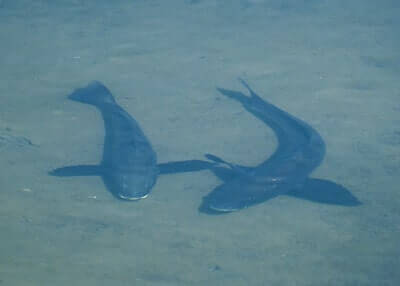
Table of Contents
How To Catch California Corbina
1. Surf Fishing
California corbina is often found in very shallow waters searching for sand crabs and clams. Use these, especially sand crabs as live bait to catch corbina when surf fishing. Sand crabs will give you the best chance of consistently catching corbina in large quantities. You can catch sand crabs during the summer using a net or a colander.
When surf fishing for corbina, look for rip currents, troughs, and deep pockets. Corbina can be found in rip currents, troughs, and deep pockets as they go in search of sand crabs. Rip currents expose sand crabs as it recede and corbinas will be in the currents searching for the exposed sand crabs. You want to go after the corbinas that are hunting down the sand crabs.
You can go to the beach when there is low tide to identify the troughs and scallops while they are still exposed. When the tide rises later, you will know where the troughs are located and fish those troughs for corbinas there.
You can also spot deep pockets when the waves crash as they will crash less frequently when riding over a deeper pocket. Additionally, the color of the water in deep pockets will be a deeper blue color than the areas around it. It will also seem more rippled. When you identify a deep pocket, you need to fish for corbina in it. A 7-9 foot rod with a 4000 series reel a 10 to 15-pound line and a Carolina rig can work well for surf fishing California corbina.
2. Sight-Casting
Sight-casting can be used to catch corbina as they can be found in shallow waters looking for sand crabs. Wear polarized sunglasses and search the shallow waters for California corbina. When you spot a fish you want to target, you need to stalk it to get a good direction it is heading and find the best opportunity to place your bait in its projected path.
You don’t want the fish to figure out that the bait showed up all of a sudden. This will make it very suspicious of the bait and may not bite. Corbina often exhibits inconsistent bite patterns.
3. Fly Fishing
Fly fishing for California corbina is a challenging yet rewarding pursuit that requires skill and finesse. Anglers typically use lightweight fly rods ranging from 7 to 9 feet in length, paired with weight-forward floating lines and fluorocarbon leaders.
Flies that mimic the natural prey of corbina, such as sand crabs, shrimp, and small baitfish patterns, are commonly used. Successful fly fishing for corbina often involves sight-fishing in shallow water, where anglers carefully stalk and cast individual fish cruising along the sandy bottom.
Presentation is key, and anglers must accurately place their flies in front of feeding corbina while maintaining a stealthy approach to avoid spooking the fish. Patience and persistence are essential virtues when fly fishing for California Corbina, but the excitement of hooking into one of these elusive fish on the fly makes it all worthwhile.
4. Pier Fishing
Pier fishing is a convenient and accessible method for targeting California corbina, particularly for anglers without access to a boat or who prefer to fish from solid ground. Anglers can fish for corbina from piers located in areas where corbina are known to inhabit sandy beaches and surf zones.
Similar to surf fishing, anglers can use a variety of bait and tackle options, including sand crabs, bloodworms, shrimp, and artificial lures. When fishing from a pier, anglers can cast their bait or lures into deeper water beyond the breaking waves, where corbina often patrol in search of food.
Patience and observation are essential when pier fishing for corbina, as anglers must be attentive to subtle bites and changes in fish behavior. Additionally, fishing during periods of low light or incoming tides can increase the chances of success when targeting California corbina from a pier.
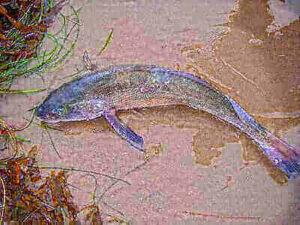
California Corbina Tackle
You can use a 7-foot light to medium rod with a high/low leader and size 6 to 4 hooks. A monofilament or fluorocarbon leader can work and use a 4-6 pound test. You can use hooks from 6 to 4/0 depending on your rig. If you have a light line, you can go with a smaller hook.
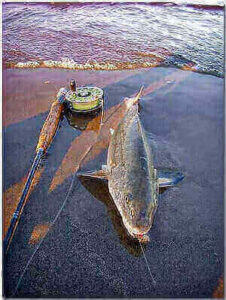
Best Baits For California Corbina
1. Crabs
Using crabs as bait for California corbina can be highly effective, as these fish are known to feed on a variety of crustaceans along sandy beaches and in the surf zone. Sand crabs, also known as mole crabs or sand fleas, are particularly popular bait choices for corbina fishing.
These small crustaceans burrow into the sand near the water’s edge, making them easily accessible to corbina and other predatory fish. Anglers often collect sand crabs by scooping them up from the sand with a sand flea rake or by hand.
Once collected, sand crabs can be rigged onto a hook using a variety of methods, including threading them onto a hook through the shell or securing them with bait thread. Alternatively, soft-shell crabs or pieces of larger crabs can also be used as bait for corbina fishing. The natural scent and movement of crabs in the water can attract corbina, enticing them to strike.
When fishing with crab bait, anglers should cast their lines into the surf zone or along the edges of sandbars where corbina are likely to forage. Patience and observation are key, as anglers must remain vigilant for signs of corbina activity and be ready to set the hook when a fish takes the bait.
2. Clams
Clams can be a highly effective bait choice for targeting California corbina, particularly along sandy beaches and in the surf zone where these fish commonly forage. Anglers often use fresh or live clams, such as littleneck clams or razor clams, as bait for corbina fishing.
These bivalves emit natural scents and oils that can attract corbina, enticing them to feed. When using clams as bait, anglers typically rig them onto a hook by threading them onto the shank or securing them with bait thread. Some anglers may also opt to use clam strips or chunks, which can release scent into the water more effectively.
The presentation of the bait is crucial, with anglers aiming to mimic the natural movements of clams in the sandy substrate. Clam baits are often cast into the surf zone or along the edges of sandbars, where corbina are known to feed.
Anglers should be prepared to adjust their rigging and casting techniques based on the prevailing conditions and the behavior of the fish. Overall, clams can be a reliable bait choice for targeting California corbina, providing anglers with a chance to hook into these prized coastal game fish.
3. Small fish
Small fish can be an effective bait choice when targeting California corbina, especially in areas where these fish are known to frequent, such as sandy beaches and nearshore coastal waters. Species like anchovies, smelt, and small mullet can all serve as enticing bait options for corbina.
When using small fish as bait, anglers typically rig them onto a hook using a variety of techniques, such as hooking them through the lips or tail or threading them onto a bait rig. Some anglers may also opt to use live baitfish, as their natural movements and vibrations can attract corbina more effectively.
The presentation of the bait is crucial, with anglers aiming to mimic the natural behavior of small fish swimming in the water. Small fish baits are often cast into the surf zone or along the edges of sandbars, where corbina are known to hunt for prey.
Anglers should be prepared to adjust their rigging and casting techniques based on the prevailing conditions and the behavior of the fish. Overall, small fish can be a productive bait choice for enticing California corbina and increasing the likelihood of a successful catch.
4. Mussels
Mussels can be a reliable and effective bait option for targeting California corbina, particularly along rocky coastal areas and jetties where these fish are commonly found. California corbina is known to forage along the ocean floor, feeding on a variety of small crustaceans, mollusks, and other bottom-dwelling organisms, making mussels a natural and appealing food source.
Anglers can use fresh or frozen mussels as bait, with frozen mussels often being convenient and readily available at bait shops. To use mussels as bait, anglers typically thread them onto a bait rig or secure them onto a hook using bait thread or small rubber bands. The presentation of the bait is important, with anglers aiming to mimic the natural appearance and movement of mussels in the water.
Mussels can be cast into areas with sandy bottoms near rocky structures or along submerged rocks and jetties, where corbina are likely to feed. Patience and attention to detail are key when using mussels as bait, as corbina can be selective feeders and may require a subtle presentation to entice a bite. Overall, mussels can be an effective bait choice for anglers targeting California corbina, offering a natural and enticing option to attract these prized coastal gamefish.
5. Marine Worms
Marine worms, such as bloodworms and lugworms, can be excellent bait choices for targeting California corbina, especially in sandy coastal areas where these fish commonly feed. California corbina are known to forage along the sandy bottom, hunting for small crustaceans, mollusks, and worms, making marine worms a natural and appealing food source.
Anglers often use fresh or preserved marine worms as bait, with bloodworms being particularly popular due to their strong scent and attractive coloration. Lugworms, on the other hand, are larger and offer a hearty meal for corbina. To present marine worms effectively, anglers typically thread them onto a bait rig or secure them onto a hook using bait thread or small rubber bands.
The key to success when using marine worms as bait is to ensure a natural presentation that mimics the movement of live prey in the water. Anglers may opt to fish marine worms on the bottom or slightly buried in the sand, where corbina are likely to root around in search of food. With their enticing scent and lifelike appearance, marine worms can entice California corbina to strike, making them a valuable bait option for anglers pursuing these elusive coastal fish.
6. Squid
Squid is a versatile bait option for California corbina fishing, particularly in areas where these fish frequent rocky bottoms or kelp beds. Squid offers several advantages as bait, including its strong scent and durability, which can attract corbina and withstand the rigors of casting and retrieval.
Anglers typically use fresh or frozen squid, either whole or in strips, depending on personal preference and fishing conditions. Whole squid can be rigged onto a hook to mimic natural prey, while squid strips can be threaded onto a bait rig for added presentation options.
Squid’s natural coloration and texture make it an enticing target for corbina, which are known to feed on a variety of marine organisms, including cephalopods like squid. When using squid as bait for corbina, anglers may experiment with different rigging techniques and presentation styles to find what works best in their local fishing grounds. Whether fished on the bottom or suspended in the water column, squid can attract California corbina and increase the chances of a successful catch for anglers targeting these prized coastal gamefish.
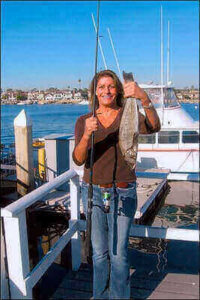
California Corbina Fishing Tips
1. Corbina is rarely in water deeper than 20 feet.
2. The best way to catch corbina is from the shore using soft-shelled crabs, shrimps, and worms.
3. Keep the line tight so you can feel the bite.
4. Keep the rod tip high and keep moving along the beach until you get bites.
5. Wear polarized sunglasses to help you spot the fish from a pier or the shore.
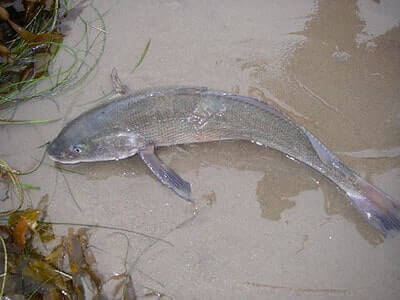
6. Use small sand crabs as bait rather than large ones.
7. Sight-casting is one way to fish for corbina.
8. You can catch California corbina all year round, but the best time is from July to October when there is an influx of warm water and sand crabs.
9. Corbina bites better early in the morning in low light conditions or at night.
10. California Corbina likes the shallow bays along sandy shorelines and oceanfront surf areas.
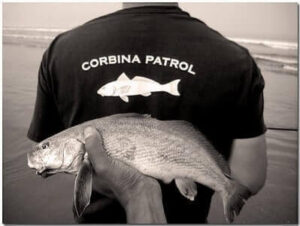
11. You can often find corbina swimming in inches of water while using their chin barbels to search for sand crabs.
12. California corbina is a schooling fish but most are found in small schools while some adults like to swim alone in the surf zone.
13. During low tides, look around beach piers for sand crabs as corbina will target that area in search of sand crabs as the tide moves inshore.
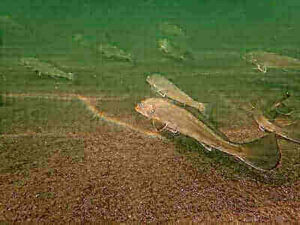
14. Live bait usually works better than lures when fishing for corbina.
15. Innkeeper worms are one of the best baits for corbina.
16. When surf fishing, look for rip currents, troughs, and deep pockets to fish for corbina. Corbinas are usually found in these areas searching for sand crabs.
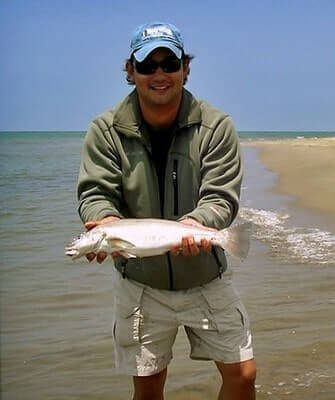
The Bottom Line
California corbina is a challenging fish to catch as it is elusive and exhibits erratic bite patterns. It is a hard fighter and likes to search shallow waters for food. In this article, we discussed all things about the corbina and shared information to help you catch it.
If you fish for other fishes like jack crevalle, spotted seatrout, and snook, you can read how to catch jack crevalle, how to catch spotted seatrout, and how to catch snook.